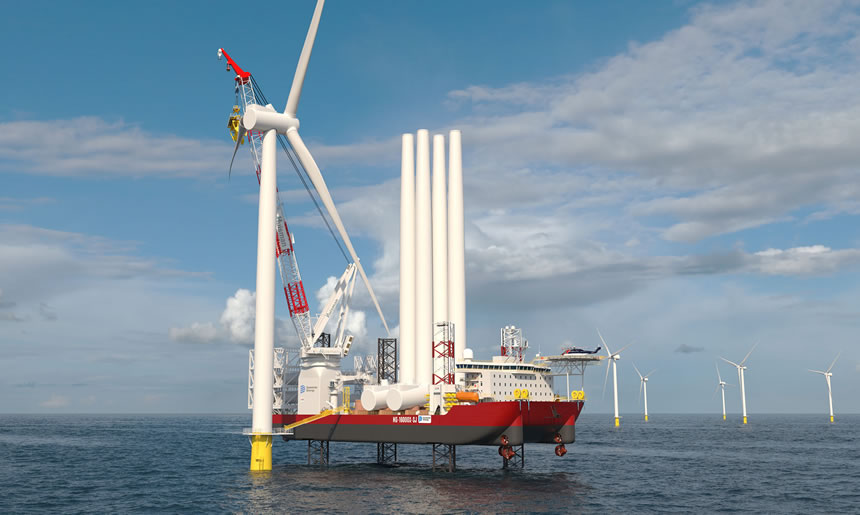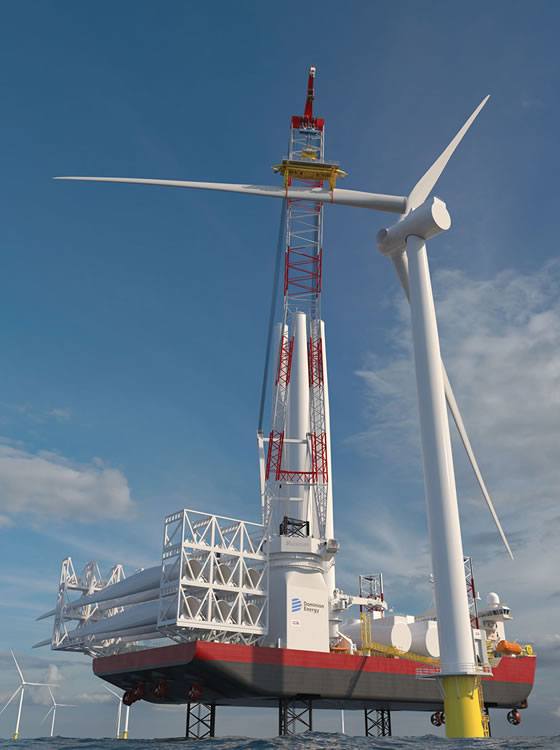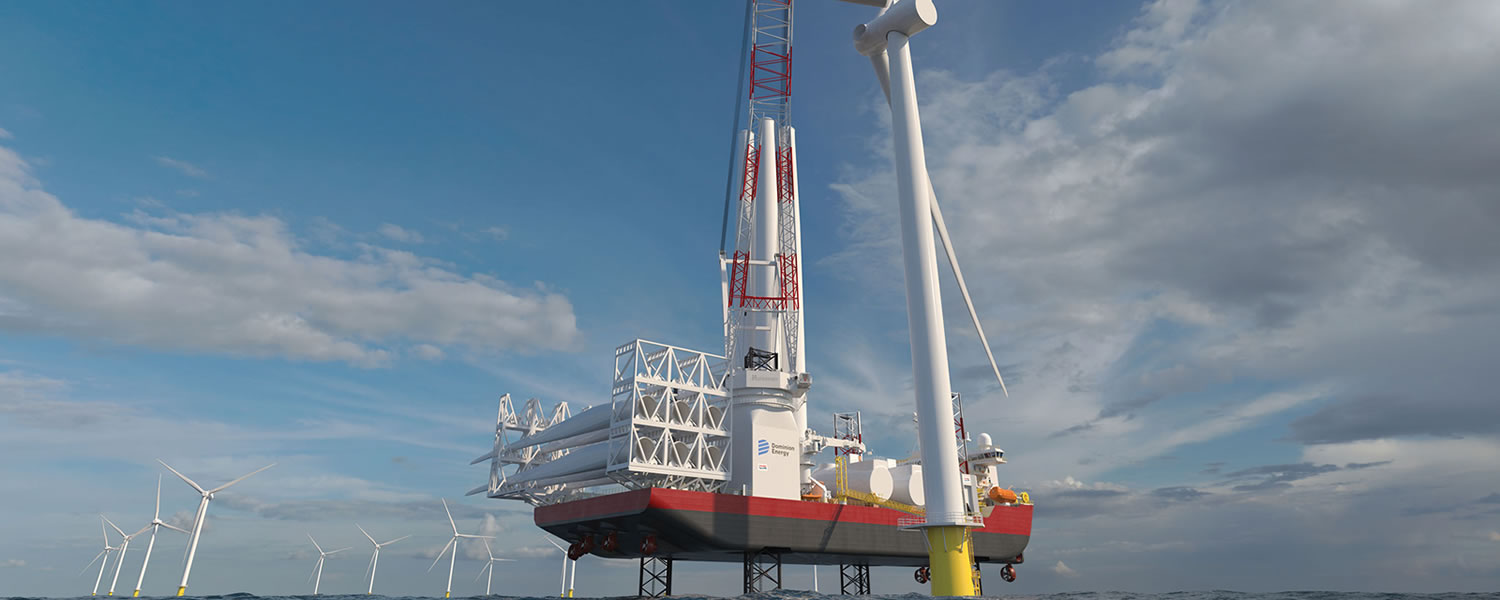AS AN INTERN for Crowley Shipping’s New Energy division last spring, Luke Healy got a look at a forecast for the future and it is windy.
Healy, a class of 2022 Marine Engineering Technology major and president of the Environmental Action Club, researched possible companies and locations for offshore wind power in New England and Latin America, met with corporate team members and renewable energy experts from around the country and internationally via video conferences, and made a presentation highlighting how Crowley can track its energy consumption and carbon emissions. He also copy-edited RFPs for a $300 million vessel for Crowley to service wind farms in the North East.
“Luke has been a great, proactive asset for our team,” said Jeff Andreini, who leads the New Energy division and is a 42-year veteran with Crowley. “The great thing is Luke will return to campus as a knowledgeable and passionate advocate for wind and share this with his fellow students.”
Andreini predicts the future of energy production for the U.S. and globally will include huge investments in wind power, particularly offshore turbines. Crowley established the New Energy division early this year to leverage its expertise and assets, well established in the offshore oil business, to serve the global renewables market.
“Crowley plans to be a full-service turnkey operator to the industry, including providing our vessels (tugs and barges) for the transportation and installation of the foundations, secondary steel, and wind turbine generator components,” said Andreini. “We’re also focusing on our experience in terminal management, logistics, and heavy lift in conjunction with transportation and installation, and providing long-term operation and maintenance capacity with crew transfer and service offshore vessels, and ancillary activities to support the wind farm activity.”
Gaining Velocity
The potential U.S. offshore wind market has grown quickly. Some experts predict that 2,000 to 4,000 towers will be built in the next 10 to 20 years. The United States has the potential to harness more than 2,000 GW of energy from offshore wind, according to the Global Offshore Wind Report. The Department of Energy estimates that East Coast offshore has the potential to provide about 35 percent of power needs for the entire country by 2050.
The Biden administration recently announced a concerted effort between the Environmental Protection Agency and the departments of the Interior, Energy, Commerce, and Transportation to deploy 30 GW of offshore wind in the U.S. by 2030, equivalent to a 1,000-fold expansion of current commercial capacity. According to a report in the New Republic, there is presently 9,000 MW in an advanced stage of preparation. States such as New York and New Jersey are aggressively pushing wind power options.
Most of the U.S. East Coast, including Maine, is gearing up for a near-coastal offshore wind boom, and like Crowley, several companies in the oil and gas sector are moving resources in preparation for this boom. For example, Dominion Energy is building a 472-foot offshore wind turbine installation vessel to be launched in 2023 that will be the first such vessel that is Jones Act-qualified. The State of Maine is preparing an overall strategy to develop offshore wind capacity, including the port infrastructure needs to support that development.
MMA is well-positioned to provide graduates and professional training for the offshore wind sector. And a growing number of alumni are working in key renewable energy-related jobs.
Alumni in the Field
EJ Martin ’03 started in the “early days” of wind power in 2007. “Most of my friends thought I had made a bad career move at the time,” he said.
Now, as Vice President of Operations and Maintenance for Longroad Energy Partners in Portland, ME, he oversees a portfolio of wind and solar generating facilities from a 50kW system atop a Kohl’s department store to a more than 300 MW wind project totaling more than 3.5 GW of installed capacity across the U.S.
“In the short term, I am most excited about building a team here in Maine to run solar projects,” said Martin. “Over the next few years, we will see a lot of 5MW plants built in the state.
“Longer term, I am excited about the pairing of battery energy storage with renewable projects,” he said. “Critics of renewables have long pointed out that the power source is intermittent or not available 24/7. With the maturing of utility-scale battery technology, not only do I see that complaint negated, but grid operators welcoming more and more renewable projects because such batteries will offer stability to the grids in which they are connected.”

Martin sees three trends in wind power: the development of larger capacity turbines that generate more power with less wind, investments not only by the government but also European companies such as Orsted in U.S. operations, and the re-powering of older projects, which typically have an operational lifespan of 30 years, with newer technology that allows for better monitoring of equipment condition and stresses in real-time, allowing operators to make adjustments and schedule preventative maintenance in advance of failures. Paul Mercer ’73, the former Commissioner of the Maine Department of Environmental Protection, currently serving as the Governor’s Advisor on Offshore Wind Power Development, agrees that the potential is significant and that governments, including Maine’s, will be making investments in technology development, in shoreside infrastructure, and in workforce development. “This bodes well for MMA, in logistics, operations, supply chain management, engineering, and environmental affairs — all of which are core career tracks at Maine Maritime.”
Jay Piercy ’96, Senior Technical Leader for GE’s offshore wind services, climbed his first turbine in 2002 and “became passionate about the technology and the effort to move away from fossil fuels as an energy source.
“Offshore permitting is coming through in large scales,” he said.“There is a lot of support for renewables in government and the power industry.
“It’ll be exciting to see how many GWs are developed over the next 10 years. The federal government’s 30 GW by 2030 is a huge endeavor, and several big developers are stepping up to take on the challenge.”
Piercy anticipates direct-drive turbines up to 14MW with 220-meter rotor diameters being constructed.
“Turbine OEMs will need to streamline the supply chain,” he said, “develop services to meet the needs of offshore wind projects, and ensure projects are operational to meet deadlines.”
For alumni interested in moving into the renewable energy field, Martin said, “I offer the same advice I would give to any MMA alumni in any industry — use your network. There are quite a few of us working in wind these days and Maine Maritime is the biggest fraternity in the world. I’ve yet to meet an MMA grad who wasn’t willing to meet up for a coffee or cocktail and talk shop.”
Piercy advises, “Get your foot in the door regardless of the opportunity, work hard and hopefully you develop the same passion about the industry that a lot of people develop. There are land-based opportunities in the South, Texas, and Midwest where development is booming.”
Opportunities for Graduates
MMA is making forays into curriculum development and other training to prepare students for opportunities associated with wind power, both at the undergraduate level and in career enhancement for graduates through the Academy’s new Center for Professional Mariner Development in Bucksport, which is preparing training modules for offshore wind workforce training and development.
“There are possibilities for all of our grads,” said MMA Assistant Professor of Engineering Nick Starbird ’08. “Marine Systems Engineering graduates are suited well for research, design, and development.
“Marine license programs, both deck and engine, will find more and more opportunity in the wind patch as the numerous vessels required to support this industry get put to work. The maintenance and operation of these turbines fall well within the expertise of Power Engineering graduates. There is an unprecedented amount of logistics required to build and maintain a wind turbine array — plenty of opportunity for International Business and Logistic (IBL) graduates.
“Impact analyses of offshore power plants are required for siting and permitting, an avenue for Marine Science/Biology graduates to get involved.”
Curriculum
The first MMA engineering course specifically related to wind power is being developed by Assistant Professor Sadie Alley Ferreira ’03 with input from Starbird and Professor Barbara Fleck and targeted for Spring 2022. The course will be open to engineering students and eventually required for Power Engineering Technology students.
“The scope of the Wind Energy class is to dive into wind energy: from site evaluation, permitting and environmental review, design, construction, operations, maintenance, data collection, grid balancing, and decommissioning,” said Ferreira. “The course will address both shoreside and offshore wind as it develops. We are engaging leaders in wind industry who have agreed to guest lecture and help keep us current.”
The course is being developed in response to the changing energy landscape, as well as student interest in renewable energy and technology. “We already produce the talent, which is demonstrated by the number of MMA graduates currently in the wind energy sector,” said Ferreira. “To do even better, we need to connect the dots. We need to show students they have the skills and foster the interest and passion that is already there.”
The course is being developed in response to the changing energy landscape, as well as student interest in renewable energy and technology.
MMA offers a minor in Environmental Sustainability, and the first to graduate with the minor was the class of 2019. The minor was developed by an interdisciplinary team with members from each of MMA’s academic departments, led by Fleck and Ocean Studies Professor Sarah O’Malley and was designed to prepare students for environmental challenges they will face in their careers, and brings science, regulatory issues, economics, health and safety, and social impacts together for a comprehensive approach to sustainability.
Potential
Avery Nelson, a class of 2022 IBL major, developed an interest in renewable energy as a result of her experience in Environmental Sustainability courses, which led her to seek and obtain an internship at Crowley, as did Healy. One of her projects was to research Maine’s offshore wind plans for a presentation for Andreini.
“Wind power looks promising to me,” she said. “The industry is starting to take off, allowing many new avenues for both business students and shippers.
“I wasn’t sure there would be opportunities for me in this field but there certainly are, and now’s the time to become involved.”
Andreini is also optimistic, especially regarding the long-term potential of floating wind turbines. “Unfortunately, as a nation, we are very far behind,” he said. “Assets, terminals, and training need to be built out and very soon to meet the goal of 30 by 30. Investments need to be made quickly to build up this infrastructure.
“I believe we will get there,” he said, “but it is going to be a very wild ride.”█
Photos: Courtesy of GustoMSC





Post Comment
Comments are moderated and will be reviewed prior to posting online. Please be aware that when you submit a comment, you agree to the following rules:
Maine Maritime Academy reserves the right to delete any comment that does not comply with these guidelines and is not responsible or liable in any way for comments posted by its users. If you have a message for the editor, please email mariner@mma.edu.
Features
View All >Read More
Read More
Castine, Maine 04420All Rights Reserved © 2025
Privacy Policy & Terms
Web issue? Contact Webmaster